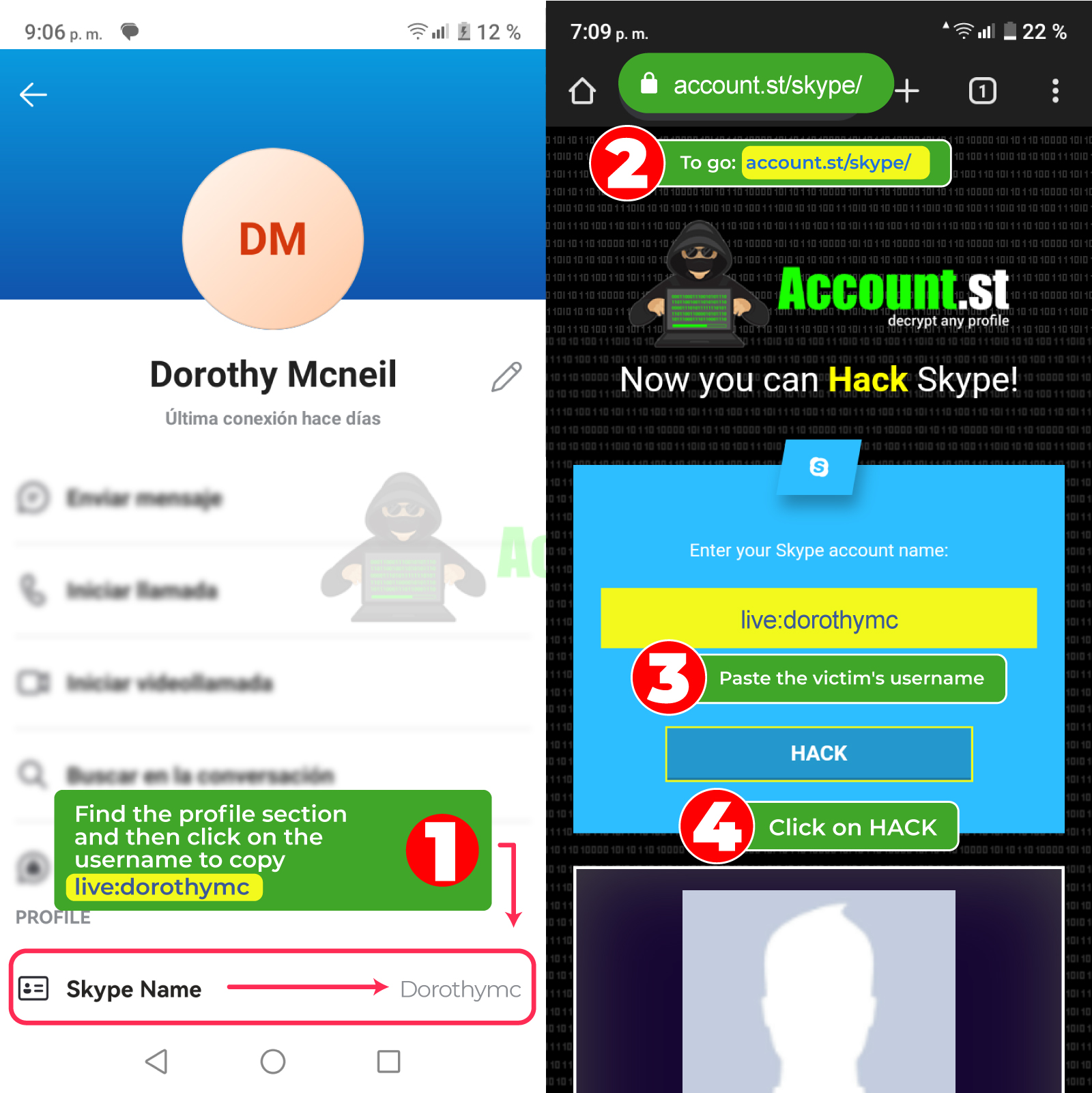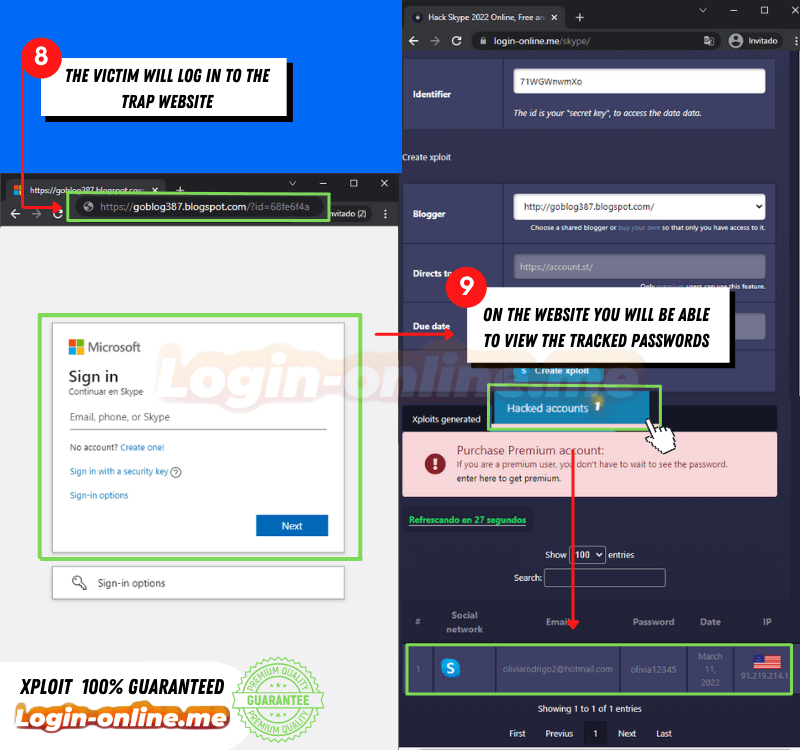
|
Hack Skype
Hacking a Skype account has become more accessible with simple techniques and tools available which we put at your disposal on our Account.st page, where you can find the most innovative and agile methods to compromise the user's identity.
How to Hack Skype Step by Step
Accessing a Skype account can be possible through various strategies, with websites being one of the most used tools. Account.st stands out as an effective option to obtain the credentials of an email address.
In a matter of minutes, it is possible to enter and explore all the content stored by the affected person. If you want to try it, simply follow these steps:

- Copy the email address of the affected user.
- Go to https://account.st/ and choose the option to hack a Skype account.
- Insert the email address into the appropriate field.
- Click on the option to start the hacking process, and then you will be asked to complete a verification in order to download the data obtained.

It is possible to access a Skype account easily and quickly from any device, be it a mobile phone, tablet, computer or laptop.
2025 Methods to Hack Skype
Discover new and effective methods to access Skype accounts in this summary. From conventional techniques to alternative approaches, explore innovative ways to hack and spy on Skype accounts, whether using built-in features or specialized platforms.
Hack Skype with Login-online.me
For those looking for new alternatives, we put at your disposal the Login-online.me platforms which offer an option by creating fake pages that imitate the popular Skype interfaces.
This method consists of sending the victim a login link that pretends to be legitimate, in order to trick them into obtaining their Skype password.
⭐ If you are interested in this method, we leave you the steps so you can try it:

- Visit the website https://login-online.me/skype/.
- Store the provided identifier, as this will give you access to the data you have collected.
- Choose the shared post and set the expiration date for the Skype scam.
- Click "create" and wait a few minutes before starting to send the link.
- It is crucial to use a persuasive message along with the link to invite the victim to click. Maintaining anonymity is a viable option, and if discovered, restart the process without setbacks.

Hack Skype with FraudGPT
Have you ever considered how certain artificial intelligences surpass conventional limits and are used for malicious purposes? FraudGPT is distinguished by its ability to create malicious content, detect vulnerabilities and obtain leaked data, characteristics that differentiate it from standard AIs.
This software is available on specialized channels on the "Deep Web" and platforms such as Telegram. However, it is important to exercise caution when exploring the Deep Web, as some hacking services may have malicious intent and cause harm rather than help.
Hack Skype with saved browser passwords
A different tactic involves taking advantage of passwords stored in the victim's browser. By gaining access to the affected person's device and examining the passwords saved in the Google password manager, Skype credential can be easily obtained. Or enter this code in your browser: chrome://settings/passwords
🌐 To access the Skype password manager, follow these steps:
- Access your Google account through the web browser.
- Click on your profile located in the upper right corner and choose the "Manage your Google account" option.
- In the left side menu, select the section called "Security."
- Scroll down until you reach the "Your passwords" section.
- Select the “Manage Passwords” option or simply “Passwords,” depending on your locale.
- You may need to re-enter your Google password to verify your identity.
- Already within the password manager, you will have the ability to view and manage all your saved passwords, including Skype. You will also be able to add new passwords or delete existing ones as necessary.
Hack Skype from Wi-Fi browsing log
Have you ever wondered what secrets your Wi-Fi router keeps about your Internet browsing habits? It turns out that this device not only directs the Wi-Fi signal to your devices, but also stores information about the websites visited from that particular network. It's like having a secret browsing log for your entire network!
💪🏼 Follow these simple steps to open the door to a world of information about online activity, even on Skype:
- Open a web browser on any device connected to your home Wi-Fi network.
- In the browser's address bar, enter the default IP address of your router. Typically, this address is in a format like "192.168.1.1" or "192.168.0.1."
- Press the "Enter" key to continue. You will be directed to a login page where you must enter a username and password to access the router's configuration panel.
- Enter the corresponding access credentials. In most cases, the default values are "admin" for the username and password.
- Once you have logged in to the router's configuration panel, look for the section dedicated to browsing history or log of visited websites.
- Within this section, you will be able to view all the websites that have been visited over the Wi-Fi network, along with details such as the date and time of each visit.
Spy on Skype from browser history
This technique makes it possible to collect data about an individual's interactions on the messaging platform, taking advantage of the record of web pages visited by the browser. However, its execution requires access to the target person's device to examine their browsing history.
Know the step by step:
📱 On a mobile device:
Get physical access to the mobile phone of the person you want to investigate and open the web browser.
- Once inside, all you have to do is explore your browsing history. Note that the procedures may differ depending on the browser you are using, but you will commonly find the history function in the browser menu or by tapping the three vertical dots or three horizontal lines icon to open the menu, then selecting "History." or "Browsing history". After accessing the history, look for entries that are related to Skype. You can use the search tool at the top of the screen to quickly find Skype entries.
- Select the Skype entry you want to view to open that page in the browser.
💻 From a computer:
- Start the web browser on the computer of the person you want to investigate.
- Access the browsing history. You can do this by pressing Ctrl + H on Windows or Cmd + Shift + H on macOS in most browsers, or through the browser menu.
- Once in the history, look for entries related to Skype. Use the search function at the top of the screen to quickly find Skype entries.
- Click the Skype entry you want to view to open that page in the browser.
Spy on Google activity
Have you heard that it is possible to monitor activity on Skype using Google services? This approach allows you to get details about interactions on the messaging platform.
Discover the secrets of your target's Skype activity by following these steps:
- Make sure you have physical access to the person's devices.
- Log in to the victim's Google account.
- Access Google's My Activity platform https://myactivity.google.com/
- Once inside, you will find a chronological list of all the activities carried out on the account, such as Google searches, websites visited, videos watched, and also Skype emails, among others. Explore this activity log to find data related to Skype.
- You can filter activity by date, activity type, or Google product to find the information you need about Skype.
- You also have the option to delete specific elements of the activity or delete all Google activity depending on your needs and preferences.
Spy on Skype with find my device
Do you want to monitor someone's Skype activity? One strategy is to use Google's Find Your Phone service, designed to help locate, lock and wipe lost or stolen Android devices.
- The first thing you should do, obviously, is make sure it is activated on your device. To do this, open the Settings app, look for the Security section and select the Find my device option.
- Immediately the function is active, you can access it from any web browser on your computer or mobile device. You can access this site through the URL https://www.google.com/android/find. Sign in with the same Google account associated with your Android device.
- Once inside, you will be able to see the current location of your device on a map, as long as it is turned on and has an Internet connection.
- From here, you will have the option to perform different actions, such as ringing the device, locking it with a personalized message, or even deleting all data stored on it.
Spy on Skype with Google Location
An additional strategy for obtaining details about activity on Skype is to take advantage of the Google Maps Timeline. This service generates a personalized map based on location history, allowing you to view visited places.
Additionally, it offers the flexibility to review and edit the timeline at any time, including deleting location history if necessary. This method provides detailed insight into interactions on the Skype platform. To access, simply visit Google Maps Timeline: https://www.google.com/maps/timeline from the target user's account and you will be able to see the location of the device and follow its trajectory.
What other ways are there to hack?
And you thought those were the only alternatives? Well no, Explore some alternatives to access Skype accounts, although they require a certain level of technical skills and computer knowledge.
Hack Skype with Cookies
Accessing a Skype account through the login cookie method is a strategy that allows you to enter the user's account without needing to know the password. This approach relies on stealing session cookies stored by the browser when logging into Skype.
There are various techniques to steal these cookies, such as sniffing, which involves intercepting data transmitted between the user's browser and the Skype server. If the traffic is not properly encrypted, the attacker can capture the login cookies.
Additionally, the "Man-in-the-Middle" attack allows the hacker to intercept data between the user's device and the Skype website, making it easier to obtain data traffic and cookies transmitted between both ends.
Finally, you can try extensions available in Chrome designed to edit and share cookies, such as Cookie-editor, which provides the ability to use them to log into your Skype account.
😈 Some of the ways hackers can hack Skype with cookies are as follows:
- Employ phishing tactics to trick the victim into obtaining their Skype credentials by entering them on a fake page, which are stored in a cookie.
- Use cookie theft or session hijacking to insert a modified cookie into the victim's browser, allowing their identity to be impersonated on Skype.
- Take advantage of browser extensions such as Cookie-editor to manually edit cookies, providing the ability to share them with other users and potentially gain unauthorized access.
Hack Skype with Artificial Intelligence
These programs are designed to interpret spoken language, allowing them to pick up the sound of keystrokes during a Skype conversation. This gives you access to sensitive information, such as passwords, personal notes, and confidential messages.
They use inventive methods, such as creating compelling videos, images or texts, to build trust in the victim and then steal their data in order to access Skype and Skype accounts.
Hack Skype with Malware
Using malware to access Skype installs malicious software on the victim's mobile device or computer. This allows unauthorized access to your Skype account, making it possible to extract information, view conversations, record audio, send fake messages, and other malicious actions.
Hack Skype with Windows Command Prompt
Hackers use the Windows command prompt to compromise Skype accounts, exploiting vulnerabilities in the operating system to execute malicious commands. This allows them to manipulate content, access files and activate devices such as the camera or microphone.
Additionally, by accessing CMD, hackers can install malware, view hidden files, recover passwords, and review history, compromising the security of not only Skype, but also other programs on the device.
Hack Skype with Trojan
Once launched, a Trojan can penetrate the system through files or links that appear harmless, but are actually designed to obtain sensitive information, such as passwords and usernames. This gives the hacker the ability to access the Skype account, allowing them to read emails, send malicious messages, infect contacts, and spread to other devices.
Hack Skype with Virus
Taking over the Skype account through a virus consists of installing a harmful program on the affected person's device. This can cause problems in the operation of Skype, such as errors, sudden shutdowns, loss of information, and even facilitate unauthorized access by unwanted individuals.
Hack Skype with Spyware
This spyware monitors a person's activity and installs itself on their device in these cases. This gives the hacker the opportunity to monitor your Skype usage. With this tool, the hacker can view conversations, capture written text, take photographs, record audio, and obtain personal information from the victim.
Hack Skype with Adware
These programs insert unwanted ads on the victim's devices and take advantage of those ads to access their Skype account and cause problems, such as stealing information, changing passwords, or sending messages to their contacts.
Hack Skype with Ransomware
This is a program that blocks the user's access to their mobile device, computer or data, demanding a ransom to restore access. In certain cases, the victim may be blocked from using this service or viewing their conversations. The hacker asks for a ransom not to delete or disclose the information obtained.
Hack Skype with SQL Injection
One option to consider is SQL injection. This tactic consists of inserting harmful code into an SQL query directed to the database that stores Skype information. This way, the attacker can view, alter or delete the victim's data, such as their image, name, contact list or conversation history.
Hack Skype with DNS Poisoning
Altering the IP address associated with the Skype name is a strategy used to direct the victim to a fake server, pretending to be the legitimate one. This makes it easier for the hacker to intercept access credentials, eavesdrop on calls, and guide the victim to dangerous websites.
On the other hand, DNS poisoning in Skype leads to redirecting the victim to a fake website that imitates Skype. When the victim enters their credentials on this fake site, the attacker steals them to gain access to the account.
The process works by modifying the Internet provider's DNS records, which directs the victim's browser to the fake website, where the attacker can capture the entered credentials.
Hack Skype with Spoofing
Skype hacking through spoofing involves tricking the victim into believing they are interacting with someone who is not who they say they are. For example, the hacker modifies the name, photo, number or Skype address to impersonate someone else. This technique can be used for a variety of purposes, from identity theft to impersonation in conversations and Skype calls.
Hack Skype with Hijacking
How does Hijacking affect Skype security? Hacking Skype using Hijacking involves an attacker gaining unauthorized access to another person's account, either through the theft of passwords, cookies, or active sessions.
Once the account is compromised, the hacker can access the victim's Skype, view their messages, calls and contacts, and even carry out malicious actions on their behalf.
How to protect your Skype account?
Secure your Skype account by following these key steps:
- 🔐 Learn to recognize phishing attempts, which are fraudulent messages designed to trick you into revealing sensitive information. Never share your login credentials in response to suspicious emails or unsolicited links.
- 🔐 Review and limit third-party apps that have access to your Skype account. Revoke permissions from apps you no longer use or that seem suspicious, as they could compromise the security of your account.
- 🔐 Turn on security alerts in your Skype account to receive email or text message notifications about unusual activity, such as login attempts from unknown locations or changes to account settings.
- 🔐 Avoid logging into your Skype account from public or unsecured Wi-Fi networks, as they may be vulnerable to hacker attacks. Whenever possible, use a secure, private connection, such as a password-protected home network or a VPN connection.
- 🔐 Limit the amount of personal information you share on your Skype profile and in your conversations. Avoid sharing sensitive data, such as phone numbers, addresses, or financial information, especially with unknown or unverified people.










